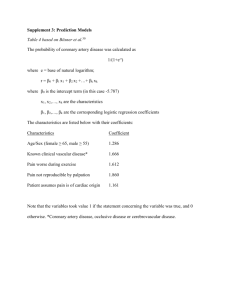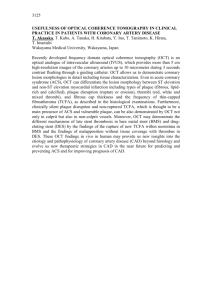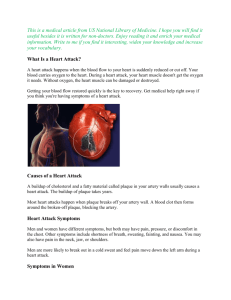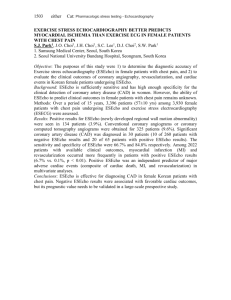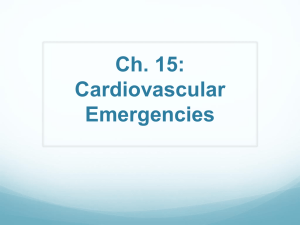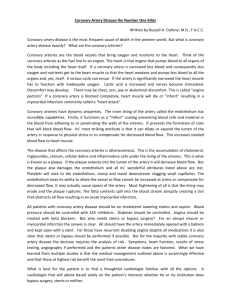Acute Coronary Syndrome - American Heart Association
advertisement
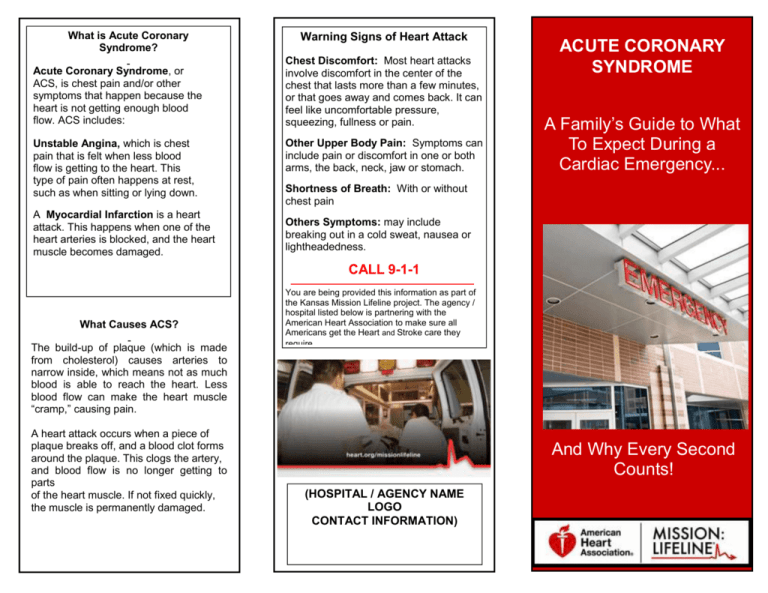
What is Acute Coronary Syndrome? Acute Coronary Syndrome, or ACS, is chest pain and/or other symptoms that happen because the heart is not getting enough blood flow. ACS includes: Unstable Angina, which is chest pain that is felt when less blood flow is getting to the heart. This type of pain often happens at rest, such as when sitting or lying down. A Myocardial Infarction is a heart attack. This happens when one of the heart arteries is blocked, and the heart muscle becomes damaged. Warning Signs of Heart Attack Chest Discomfort: Most heart attacks involve discomfort in the center of the chest that lasts more than a few minutes, or that goes away and comes back. It can feel like uncomfortable pressure, squeezing, fullness or pain. Other Upper Body Pain: Symptoms can include pain or discomfort in one or both arms, the back, neck, jaw or stomach. ACUTE CORONARY SYNDROME A Family’s Guide to What To Expect During a Cardiac Emergency... Shortness of Breath: With or without chest pain Others Symptoms: may include breaking out in a cold sweat, nausea or lightheadedness. CALL 9-1-1 What Causes ACS? The build-up of plaque (which is made from cholesterol) causes arteries to narrow inside, which means not as much blood is able to reach the heart. Less blood flow can make the heart muscle “cramp,” causing pain. A heart attack occurs when a piece of plaque breaks off, and a blood clot forms around the plaque. This clogs the artery, and blood flow is no longer getting to parts of the heart muscle. If not fixed quickly, the muscle is permanently damaged. You are being provided this information as part of the Kansas Mission Lifeline project. The agency / hospital listed below is partnering with the American Heart Association to make sure all Americans get the Heart and Stroke care they require. And Why Every Second Counts! (HOSPITAL / AGENCY NAME LOGO CONTACT INFORMATION) What Do I Need To Do? If you haven’t left for the hospital yet, the most important thing is to get there SAFE! Bring either a list of current medications, or medication bottles for the doctors and nurses to review. Do NOT give any medications to your loved-one once they arrive at the hospital. The staff will give any medications that are safe at this time. Be ready to answer questions about your loved-one’s health history. There may be many people in the room asking a lot of questions, and some of these questions might even be asked more than once. This can feel stressful, especially since you are probably already worried. Staying calm and answering the questions the best you can will help to make sure that the medicines and tests that are given to your loved-one are safe. IMPORTANT: Be sure to tell the emergency room doctor if your loved-one has any history of Coronary Artery Disease, heart attacks, bleeding disorders, allergies to aspirin or contrast dye, or other history that you feel they might need to know. Also, be sure to alert the physician if your loved-one has taken any medication in the past 72 hours for erectile dysfunction, such as Cialis® or Viagra®. Why the Rush? Your loved-one has shown symptoms of ACS, or Acute Coronary Syndrome. Until more tests are done, these symptoms will be treated like a heart attack is occurring. These symptoms could include chest pain or pressure, shortness of breath, sweating, feeling dizzy, or pain in the neck or jaw. Since 85% of all heart muscle damage happens during the first hour of a heart attack, every second truly does count. TIME IS MUSLE! What Happens In The Cath Lab? The Cath Lab is located near to the Emergency Department. Inside the lab, your loved-one will be moved onto a table, and hooked up to monitoring equipment. Their groin (or, occasionally their wrist) will be shaved, cleaned with a special soap, and numbed-up. A small hollow tube (called a sheath) will be put into the artery. Long catheters will be threaded into the sheath and dye will be injected through them. When injected, a special type of xray is used to see the contrast dye in the arteries and find the blockage. A wire is placed through the blockage, and balloons and/or stents are guided over the wire and through the blockage. Balloons are inflated, pushing the plaque out of the way, and a stent is left in place, holding the artery open. What is Going to Happen Now? On the way to the hospital, the ambulance crew will apply oxygen, start IV’s, and, if possible, do a 12-lead EKG, which is a painless test that can show if there is a blockage in one of the heart arteries. If they see certain changes on the EKG, they may call a Code STEMI, which lets the emergency room doctors know that a patient is on the way in who might be having a heart attack. If a Code STEMI is called, a special team will be called in to take your loved-one to the cath lab. While waiting for the team to arrive, the emergency nurses and doctors will check blood pressures, hook up heart monitors, draw blood, give medicines, and other things to get ready for the cath lab. Your loved-one will be given medicines to keep them comfortable. They might also be given other drugs, such as blood thinners, if needed. Afterwards, they will be taken upstairs to a room where they will usually stay overnight. Sometimes, the sheath is left in place until it can be safely taken out a few hours later, after the blood thinners have worn off. Once the sheath is removed, it will be very important for them to be still and not bend that leg or raise their head off the pillow for several hours, as this can cause bleeding.

